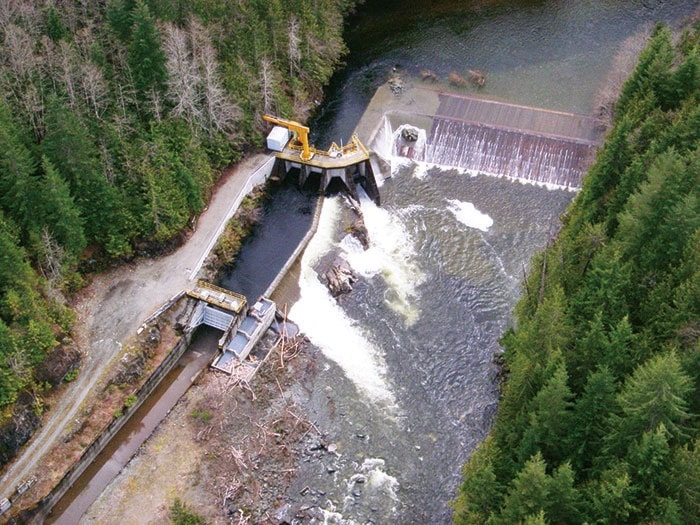A fish conservation organization is adding its support to the Campbell River Salmon Foundation’s bid to persuade BC Hydro to decommission the Salmon River Diversion.
The Comox Valley chapter of the Steelhead Society of British Columbia wrote a letter to the utility earlier this month suggesting the power-generating canal be removed because it’s a threat to fish stocks.
“Because of the state of disrepair, Hydro has not used the diversion since June of 2010,” wrote Larry Peterson, chair of the Comox Valley’s Steelhead Society chapter. “From a fiscal point of view, the cost of repairs would run into tens of millions of dollars, which we perceive as wasted dollars for a facility which stole water and compromised fish populations from the beginning.”
The Salmon River diversion canal is a three-kilometre long concrete tunnel located west of the city, built by Hydro to divert water from the Salmon River to the Lower Campbell reservoir via Brewster Lake. Hydro says about 10 per cent of the water that enters the Campbell system, on average, comes from the Salmon River Diversion.
Mike Gage of the Campbell River Salmon Foundation said the Salmon River is 82 kilometres long but 42 kilometres of the river can’t be used by the fish because they can’t make it past the concrete tunnel. Gage said Hydro, when it constructed the diversion in 1958 should have included an alternate route for the fish.
“Because they didn’t have an adequate passage around the diversion dam, they were out of compliance,” said Gage. “They’ve promised us a proper fish passage by 2015 but they’re out of compliance until they provide us with a proper diversion.”
Gage said it was the Campbell River Salmon Foundation that pointed this out to BC Hydro back in December of 2007.
Stephen Watson, spokesperson for BC Hydro, said the corporation intends to have a fish passaged in place for November 2015 and the facility fully working by 2018.
“When BC Hydro went through the comprehensive British Columbia Utilities Commission review process for the John Hart project, the Salmon River facility was part of that business case,” Watson said. “BC Hydro is also deciding on improving or replacing, including potentially moving, the downstream fish screen in the canal to keep steelhead and coho in the Salmon River when the canal is operating. The cost of the project has not been set yet as there are multiple ways to deal with the fish passage issues, for example. We look to provide a cost estimate in 2014.”
Hydro has not been diverting water from the Salmon River Diversion dam since June 2010 due to some concrete panels in the canal that need to be replaced or fixed. Hydro became aware of the problem in 2010 after five elk drowned over a two year period. It’s believed the elk slipped on some ice and fell down the side of the three-metre high concrete walls of the diversion canal, couldn’t get back out and either drowned to death when the flume was full of water or starved to death when it was empty.
In response, BC Hydro built a fence, which was completed in November, 2011, to protect the elk and in the process discovered “the extremely poor condition of the concrete portion of the canal,” according to Peterson.
Peterson said both the Steelhead Society and members of the Campbell River Salmon Foundation feel the Salmon River Diversion is unnecessary and would like to see it gone.
“Steelhead Society members and Campbell River volunteers question the whole concept of stealing water from one river to supplement another, especially from a river such as the Salmon with its rich fish producing capacity,” Peterson said. “Should the Salmon River Diversion be decommissioned, fish stocks in the Salmon River system would gain unrestricted access to an additional 42 kilometres of prime spawning and rearing water, including a likely increase of iconic Salmon River steelhead populations of 30 per cent, and BC Hydro would save tens of millions of dollars (in repairs).”
Watson said those concerns are taken seriously by Hydro.
“It’s important to stress that the fish issues at the Salmon River Diversion are important to BC Hydro, and the work has only been possible by the First Nation partnership, and that of the engaging involvement of Fisheries and Oceans Canada and Ministry of Forest, Lands and Natural Resource Operations,” Watson said. “Important stakeholder groups like the Campbell River Salmon River Foundation and the Sayward Fish and Game Club have been involved since day one. We are all moving in the right direction.”
While BC Hydro says it “rarely” removes dams, it’s not unheard of.
The utility decommissioned the Heber River dam just east of Gold River one year ago due to its poor condition. The earthfill dam and woodstave pipeline was successfully removed and the site remediated in 2012, at a cost of about $13 million.
